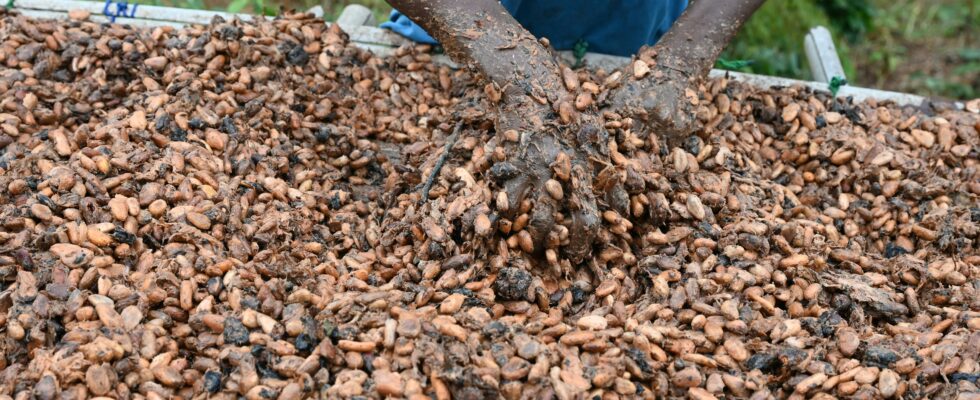(BFM Bourse) – Cocoa prices are soaring to historic levels, due to poor harvests in the main producing countries.
Do you find that the price on the shelf of your favorite chocolate bar has skyrocketed? That the checkout is more bitter than sweet? It’s not just a feeling. The price of cocoa, which is the main raw material for your chocolate pleasures, is evolving at prices not seen for 50 years in New York and London.
At the last count, the futures contract on a tonne of cocoa in New York crossed the $6,000 mark, beating its highest level since 1977 at $5,379. Across the Channel, a tonne costs nearly 5,000 pounds sterling. The price of a tonne of cocoa has therefore doubled in the space of a year and a half.
Obviously, this does not mean that the prices of chocolate increase to such an extent over one year, since beyond the raw material other costs for which inflation is probably lower (transport, processing, packaging, distribution , marketing, etc.) are taken into account in the final price of the tablets.
A few months before Easter, how can we explain this surge in prices? The increase in prices can be explained by pressures on production while at the same time demand is increasing.
Supply lower than demand
For several months, harvests have stopped in Ivory Coast and Ghana, the main cocoa producers, due to unfavorable weather conditions.
“What caused all this? [perturbations sur l’offre], it is the El Niño phenomenon which is currently raging. It really affects crops,” David Branch, senior vice president of the Wells Fargo Agri-Food Institute, was quoted as saying by CNBC.
The El Niño climatic phenomenon results in an increase in water surface temperature, causing episodes of heat and drought in the West African region. While cocoa remains a precarious crop that needs many optimal conditions to thrive, including consistent temperatures or protection from the wind.
In addition to precarious metrological conditions, diseases disrupt the cocoa supply, notably the cocoa virus. swollen shoot, or cocoa shoot edema virus. This disease affects cocoa fields in Ghana and other West African countries that grow the plant, explains the National Institutes of Health. This institute adds that attempts to develop resistant varieties since the discovery of the disease in 1936 have been unsuccessful.
And if these phenomena were not enough, Ivory Coast’s production should be 100,000 tonnes lower than contractual sales, explains Bloomberg. In this context, this country which represents more than 40% of world production will have to use reserves from the next harvest to honor sales previously made at lower prices.
“This is the third year in a row that the cocoa supply is insufficient, and the situation is not expected to improve in the near future,” Sergey Chetvertakov, principal research analyst for cocoa markets, told CNBC. and sugar at S&P Global.
For the 2022-2023 season which ended in September, the International Cocoa Organization (ICO) estimated this market deficit at 100,000 tonnes.
A ton at $7,000?
Meanwhile, consumers are increasingly fond of cocoa sweets. This agricultural material is in fact the basis for many everyday consumer products. Its paste is used to produce tablets or candies while its powder is used for flavorings in ice creams or spreads.
These tensions between supply and demand therefore materialize in prices. Quoted by Bloomberg, Judy Ganes, president of J. Ganes Consulting, explains that the shortage of physical beans is leading to “panic” buying, with companies trying to lock in futures contracts to protect themselves against price fluctuations.
Citigroup analysts therefore expect the price of a tonne to continue to soar. “Prices could remain high until the second half of 2025 and even exceed the $7,000 mark if production prospects in West Africa remain bleak,” they detailed in a note cited by Bloomberg.
On the shelves, the bill is obviously steep. Chocolate prices have risen 11% over the past year, according to consumer intelligence database NielsenIQ, using data compiled through Jan. 27. “Chocolate prices are at their highest in years,” a target=”_blank” href=”https://www.cnbc.com/2024/02/14/valentines-day-chocolate-prices- higher-as-cocoa-shortfall-spikes.html”>a representative from NielsenIQ told CNBC.
Cocoa is not the only material to suffer from heatstroke. Sugar, which is also used in the manufacture of precious cocoa sweets, is not left out. The price of the raw material is expected to increase by 20% in 2024, with the global market expected to be in deficit during the next season, according to a recent Reuters poll of 12 traders and analysts.
Here too, climatic conditions affect the sugar supply. Heat waves in Asia weighed on harvests, particularly in India, which is none other than the world’s leading producer of sugar and the second largest exporter after Brazil. The Indian government wanted to calm the rise in prices by applying a series of restrictions on exports.
“The sugar market remains under pressure. It is not healthy to rely on a single source of supply, and South-Central Brazil cannot save the market alone. Without growth in India, global sugar production sugar in 2024/2025 is likely to fall,” trading and supply chain services company Czarnikow told Reuters.
Sabrina Sadgui – ©2024 BFM Bourse
